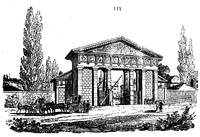358. Public gardens at Carlsruhe. Several of the streets and squares are planted with rows of trees. In one of them is a fine avenue of Platanus; in another, one of catalpa; several of acacia, and the trees in front of the barracks are ᆭ'sculus carnea and rubicunda. In the open space in front of the palace are triple and quadruple lines of trees of a variety of sorts; and among these are placed, during the summer season, some hundreds of large orange trees in tubs, covered with blossoms and fruits. The fragrance thus diffused through the town in the beginning of summer, with the music of the birds in the surrounding woods, is said to be delightful, and altogether unequalled in Germany. All the public have the enjoyment, not only of these orange groves, and of the public English garden, but of the park and gardens of the grand duke. Indeed, a prince in Germany enjoys nothing in the open air that is not partaken by all his people; and from this circumstance we in part account for the continued existence, at so advanced a period of society, of so many petty princes, each with immense palaces and extensive gardens. The people are highly taxed to keep up these gardens, but they have almost as much enjoyment of them as if they were their own. One of the finest circumstances in Carlsruhe is, that in two directions the forest of Hartwald comes up to the gates of the city. These gates are very handsome; one of them, the Durlacher Thor (fig. 110.), is by the architect Muller; and the other, the Ettlinger Thor (fig. 111.), is by the celebrated Weinbrenner, who may be designated the Nicholson of Germany. The public English garden at Carlsruhe contains about sixty acres of a perfectly flat surface, and a piece of water. It is surrounded and crossed in all directions by winding roads, which give it that degree of sameness, as a natural garden, which the Bois de Boulogne, near Paris, has as an artificial one. The conspicuous defect in the plantations, at Carlsruhe, is the want of evergreens. This want, however, does not result from any ignorance, on the part of the planters of trees, of the different species of evergreens that are to be purchased in European nurseries, but from the great severity of the winters, which destroys, if not every year, at least every three or four years, when a winter is unusually severe, many of the species. It is this want of evergreens that gives such a cold and bare appearance to continental gardens during winter. In the summer the heat of the sun and clearness of the air give such a brilliancy to the colours of the lovers as to render the public gardens on the Continent far superior to those of England; but in winter the case is the reverse, and the gardens of England have an im-mense superiority.



